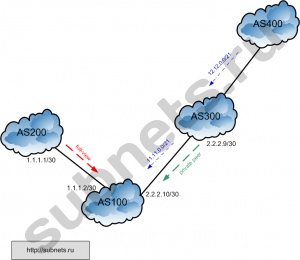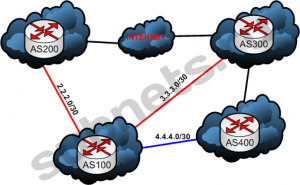С первого момента как я познакомился с оборудованием Juniper серии «M» я хотел попробовать фичу с логическими системами, т.е. создать роутер внутри роутера, но все как то руки не доходили. То времени не было, то свободной автономки с адресами.
И вот оно случилось, снова появилась свежеполученная AS с блоком адресов и я все же выкроил время для теста.
Пишу данный пост, что бы потом самому не забыть как это делалось, т.к. м.б. я тупой или жара так влияет на мозг человека, но как законектить основную систему с виртуальной я догнал не сразу, даже после того как «покурил» мануалы на juniper.net.
Дано
- Juniper M7i
- на нем уже поднят BGP с несколькими апстримами
Задача
Сделать виртуальный роутер (logical-system) внутри реального роутера, соединить их по протоколу BGP и проанонсировать новую ASку в Инет.
Connect Logical System BGP to Main system BGP.
Решение
Logical systems perform a subset of the actions of a physical router and have their own unique routing tables, interfaces, policies, and routing instances. A set of logical systems within a single router can handle the functions previously performed by several small routers.
The following are supported on logical systems:
Open Shortest Path First (OSPF), Intermediate System-to-Intermediate System (IS-IS), Routing Information Protocol (RIP), RIP next generation (RIPng), Border Gateway Protocol (BGP), Resource Reservation Protocol (RSVP), Label Distribution Protocol (LDP), static routes, various multicast protocols, and IP version 4 (IPv4) and version 6 (IPv6) are supported at the [edit logical-systems protocols] hierarchy level.
Basic Multiprotocol Label Switching (MPLS) for core provider router functionality is supported at the [edit logical-systems protocols mpls]] hierarchy level.
All policy-related statements available at the [edit policy-options] hierarchy level are supported at the [edit logical-systems policy-options] hierarchy level.
Most routing options statements available at the [edit routing-options] hierarchy level are supported at the [edit logical-systems routing-options] hierarchy level. Only the route-record statement is not supported at the [edit logical-systems routing-options] hierarchy level.
Graceful Routing Engine switchover (GRES) is supported.
You can assign most interface types to a logical system, including SONET interfaces, Ethernet interfaces, Asynchronous Transfer Mode (ATM) interfaces, ATM2 interfaces, Channelized Q Performance Processor (QPP) interfaces, aggregated interfaces, link services interfaces, and multilink services interfaces.
Source class usage, destination class usage, unicast reverse path forwarding, class of service, firewall filters, class-based forwarding, and policy-based accounting work with logical systems when you configure these features on the physical router.
Multicast protocols, such as Protocol Independent Multicast (PIM) and Distance Vector Multicast Routing Protocol (DVMRP) are supported at the [edit logical-systems logical-system-name protocols] hierarchy level. Rendezvous point (RP) and source designated router (DR) functionality for multicast protocols within a logical system is also supported.
The Bidirectional Forwarding Protocol (BFD) is supported.The following restrictions apply to logical systems:
You can configure a maximum of 15 logical systems on one physical router.
The router has only one configuration file, which contains configuration information for the physical router and all associated logical systems. Master users can access the full configuration. However, logical system users can access only the portion of the configuration related to their particular logical system.
All configuration commits performed by a logical system user are treated as commit private. For more information on the commit private command, see the JUNOS System Basics Configuration Guide.
If a logical system experiences an interruption of its routing protocol process (rpd), the core dump output is saved in a file in the following location: /var/tmp/rpd_logical-system-name.core-tarball.number.tgz. Likewise, if you issue the restart routing command in a logical system, only the routing protocol process (rpd) for the logical system is restarted.
If you configure trace options for a logical system, the output log file is stored in the following location: /var/tmp/logical-system-name.
The following Physical Interface Cards (PICs) are not supported with logical systems: Adaptive Services PIC, ES PIC, Monitoring Services PIC, and Monitoring Services II PIC.
Sampling, port mirroring, IP Security (IPsec), and Generalized MPLS (GMPLS) are not supported.
Label-switched path (LSP) ping and traceroute for autonomous system (AS) number lookup are not supported.
If you configure multiple logical systems, you can configure a VPLS routing instance only for the first logical system configured at the [edit logical-systems logical-system-name routing-instances instance-name protocols vpls] hierarchy level.
Начинаем «курить» мануалы:
Более-менее понятно, что соединить осноной роутер (main) с виртуальным (logical-system) можно через интерфейсы. Но как ?
Читаем мануалы далее и выясняем, что сделать это можно или с помощью петли, т.е. тупо соединив проводом два физических порта маршрутизатора (один порт будет принадлежать реальной системе, а второй порт виртуальной) или с помощью «Logical Tunnel Interface«.
Соединять с помощью провода между двумя реальными интерфейсами роутера я не мог, в виду отсутствия свободных, остается «логика»:
On M Series and T Series routers, logical tunnel interfaces allow you to connect logical systems, virtual routers, or VPN instances. The router must be equipped with a Tunnel Services PIC or an Adaptive Services Module (only available on M7i routers)
Такс и где же этот встроенный Tunnel Services PIC ?
А вот он:
root@juniper> show chassis hardware
FPC 1 E-FPC
PIC 2 BUILTIN BUILTIN 1x Tunnel
Что видно в интерфейсах:
root@juniper> show interfaces lt-1/2/0
Physical interface: lt-1/2/0, Enabled, Physical link is Up
Interface index: 142, SNMP ifIndex: 191
Type: Logical-tunnel, Link-level type: Logical-tunnel, MTU: Unlimited, Speed: 800mbps
Device flags : Present Running
Interface flags: Point-To-Point SNMP-Traps
Link flags : None
Physical info : 13
Current address: 00:1f:12:d5:a0:bc, Hardware address: 00:1f:12:d5:a0:bc
Last flapped : 2010-07-17 00:24:41 MSD (2w6d 10:13 ago)
Input rate : 3088 bps (4 pps)
Output rate : 3088 bps (3 pps)
Получается, что все что нам нужно для выполнения задачи присутствует.
Прочитав Configuring Logical Tunnel Interfaces меня напрягли слова:
To connect two logical systems, you configure a logical tunnel interface on both logical systems.
«Эмм…. две логические…..» подумал я, а как же быть если я собираюсь законектить не две логические системы, а логическую и реальную ?
Смотрю на картинку в примере настройки (Example: Configuring Logical Systems) и вижу что опять же виртуальные роутеры соединяются с реальными, но нигде реальные роутеры не соединяются с виртуальнфми внутри себя. Так делать нельзя ? Хм… как минимум странно.
Зрим в пример туннельного интерфейса:
lt-fpc/pic/port {
unit logical-unit-number {
encapsulation encapsulation;
peer-unit unit-number; # peering logical system unit number
dlci dlci-number;
family (inet | inet6 | iso | mpls);
}
}
Хм…. вроде все понятно, а вроде и нет ? Что такое peer-unit и какой номер указывать ? Читаем о peer-unit:
Syntax
peer-unit unit-number;
Hierarchy Level
[edit interfaces interface-name unit logical-unit-number],
[edit logical-systems logical-system-name interfaces interface-name unit logical-unit-number]
Release Information
Statement introduced before JUNOS Release 7.4.
Description
Configure a peer relationship between two logical systems.
Options
unit-number—Peering logical system unit number.
Usage Guidelines
See Configuring Logical Tunnel Interfaces.
Required Privilege Level
interface—To view this statement in the configuration.
interface-control—To add this statement to the configuration
Стало понятнее ? Мне нет….
Дальнейшее «курение» мануалов просветления в этом вопросе не принесло. Практика, попытки сделать хоть что то, тоже. Все они заканчивались выводом разнообразных ошибок при коммите (commit), например:
peer-unit needs to be configured for logical tunnel interface
error: configuration check-out failed
encapsulation needs to be configured for logical tunnel interface
error: configuration check-out failed
Или о том что интерфейсы реальной системы пересекаются с виртуальной:
Interface lt-1/2/0.1 is also configured at the top-level
error: configuration check-out failed
Либо реальная система не видела виртуальную (не было пинга).
Ну что ж, обратимся к великому гуглу ! Но толи я не так искал, тли не так читал 🙂 не знаю, но ответа на свой вопрос я по прежнему не получил.
Листая форум на juniper.net, а затем повторное прочтение Configuring Logical Tunnel Interfaces навели меня на мысль о том, что нужно и в реальном (main) роутере и в виртуальном настраивать именно туннельный интерфейс и «натравливать» их друг на друга.
Ну что ж, попробуем. Начнем с интерфейсов.
Для начала создадим наш логический роутер (для примера имя ему дадим virtual-bgp-router), переходим в режим конфигурации и начинаем:
[edit]
root@juniper# set logical-systems virtual-bgp-router
Затем создадим наш туннельный интерфейс, я возьму номер 999, вы ессно можете указать любой понравившийся вам номер юнита, которого ещё нет на этом интерфейсе:
[edit]
root@juniper# set logical-systems virtual-bgp-router interfaces lt-1/2/0 unit 999
Зададим инкапсуляцию:
[edit]
root@juniper# set logical-systems virtual-bgp-router interfaces lt-1/2/0 unit 999 encapsulation ethernet
Зададим с каким юнитом основного (main) роутера мы будем соединяться:
[edit]
root@juniper# set logical-systems virtual-bgp-router interfaces lt-1/2/0 unit 999 peer-unit 333
Добавим IP-адрес на интерфейс:
[edit]
root@juniper# set logical-systems virtual-bgp-router interfaces lt-1/2/0 unit 999 family inet address 192.168.1.2/24
Так, с виртуалкой пока закончили, теперь нужно реальному роутеру объяснить что к чему. Настроим туннельный интерфейс и на нем.
[edit]
root@juniper# set interfaces lt-1/2/0 unit 333
Создали unit 333, тот юнит, который мы указали при создании туннельного интерфейса в логическом роутере, в кач-ве peer-unit.
Затем все действия точно такие же как делали выше, зададим инкапсуляцию:
[edit]
root@juniper# set interfaces lt-1/2/0 unit 333 encapsulation ethernet
Зададим с каким юнитом виртуального роутера мы будем соединяться:
[edit]
root@juniper# set interfaces lt-1/2/0 unit 333 peer-unit 999
Добавим IP-адрес на интерфейс:
[edit]
root@juniper# set interfaces lt-1/2/0 unit 333 family inet address 192.168.1.1/24
Ну вот, в первом приближении и все. Коммитим конфигурацию и смотрим, все ли работает как надо.
Для начала проверим есть ли у нас пинг с реального роутера на виртуальный:
[edit]
root@juniper# run ping 192.168.1.2
PING 192.168.1.2 (192.168.1.2): 56 data bytes
64 bytes from 192.168.1.2: icmp_seq=0 ttl=64 time=0.910 ms
64 bytes from 192.168.1.2: icmp_seq=1 ttl=64 time=0.802 ms
64 bytes from 192.168.1.2: icmp_seq=2 ttl=64 time=0.839 ms
^C
— 192.168.1.2 ping statistics —
3 packets transmitted, 3 packets received, 0% packet loss
round-trip min/avg/max/stddev = 0.802/0.850/0.910/0.045 ms
Затем наоборот, из виртуального на реальный:
[edit]
root@juniper# run ping logical-system virtual-bgp-router 192.168.1.1
PING 192.168.1.1 (192.168.1.1): 56 data bytes
64 bytes from 192.168.1.1: icmp_seq=0 ttl=64 time=0.932 ms
64 bytes from 192.168.1.1: icmp_seq=1 ttl=64 time=0.842 ms
64 bytes from 192.168.1.1: icmp_seq=2 ttl=64 time=0.866 ms
^C
— 192.168.1.1 ping statistics —
3 packets transmitted, 3 packets received, 0% packet loss
round-trip min/avg/max/stddev = 0.842/0.880/0.932/0.038 ms
Пинг в наличии ! А значит и все остальное, по нашей задаче BGP пиринг между реальной системой и виртуальной, уже можно воплощать в жизнь.
Как поднимать BGP на Juniper в этой статье я расписывать не буду, т.к. уже делал это в статье «Настройка протокола BGP на оборудовании Juniper«, скажу лишь что в виртуальном роутере все настраивается точно так же как и в реальном, т.е. переходим в режиме редактирования в «ветку» своего виртуального роутера:
[edit]
root@juniper# edit logical-systems virtual-bgp-router
Забываем о том, что это виртуалка и настраиваем так же как обычный роутер. Т.е. поехали:
[edit]
root@juniper# set protocols bgp local-as 12345
где «12345» есть наша свежеполученная AS, затем настраиваем BGP пир (создаем BGP соседа 192.168.1.1 (реальный роутер) и т.д. и т.п.
После того как вы закончите с настройкой протокола BGP на виртуальном роутере, не забудьте создать BGP соседа (192.168.1.2) и в реальном роутере.
По итогу получаем самое обычное взаимоотношение по протоколу BGP между реальным роутером и виртуальным 😉
Реальный роутер видит по BGP виртуальный и получает от него один свой префикс от новой ASки:
root@juniper> show bgp summary | match 192.168.1.2
192.168.1.2 12345 2629 77689 0 0 01:40:19 1/1/1/0 0/0/0/0
Ну и наборот, виртуальный видит реальный роутер, который сгружает ему full-view таблицу:
root@juniper> show bgp summary logical-system virtual-bgp-router
Groups: 1 Peers: 1 Down peers: 0 Peer AS InPkt OutPkt OutQ Flaps Last Up/Dwn State|#Active/Received/Accepted/Damped... 192.168.1.1 54321 77697 2639 0 0 01:44:37 323070/323070/323070/0 0/0/0/0
З.Ы. Внутри виртуального роутера можно создавать и реальные интерфейсы этого роутера, таким образом вы можете связать виртуальный роутер с любой внешней железкой.
З.Ы.Ы. При копировании статьи ссылка на источник ОБЯЗАТЕЛЬНА ! Пожалуйста, уважайте чужой труд.
Автор: Николаев Дмитрий (virus (at) subnets.ru)
 Отправить на почту
Отправить на почту








